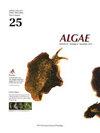菲律宾索索贡东部的海藻民族植物学
IF 2.4
3区 生物学
Q1 MARINE & FRESHWATER BIOLOGY
引用次数: 3
摘要
关于菲律宾索索贡东部海藻的知识参差不齐。索索贡东部不仅是海藻多样性高的地区之一,而且那里的当地人也与海藻互动了很长时间。尽管人们认为海藻对索索加农很重要,但民族植物学记录却缺失了。在这项研究中,我们记录了关于海藻利用的传统知识,并确定了知识在索索贡东部当地人之间的传播率。给出了12种具有烹饪和药用价值的已确定物种的方言名称和制备方式。10种被食用,3种被用于治疗。民族植物学指标显示,冠藻和刺藻是最重要的海藻。被引用最少的是总状蕨。我们的研究表明,东索索贡的大部分海藻资源仍未得到充分开发,因为已确定的民族类群仅占该地区报告的海藻物种多样性的5%左右。索索贡东部的海藻知识在不同年龄组中似乎是同质的,主要知识来源偏向于女性亲属(母亲和祖母)和作为继承人的儿童。停止对海藻的了解可能会带来潜在的代价,因为很大一部分人口没有将他们的知识传播给其他人。我们的研究进一步促进了提供复杂资源管理建议的兴趣,这些建议考虑了索索贡东部及其他地区海藻选择和使用的传统知识和科学知识之间的关系。本文章由计算机程序翻译,如有差异,请以英文原文为准。
Seaweed ethnobotany of eastern Sorsogon, Philippines
Knowledge on the seaweeds of eastern Sorsogon in the Philippines is uneven. Not only is eastern Sorsogon among the areas of high seaweed diversity but locals there have interacted with seaweeds for ages. Despite seaweeds’ assumed importance to Sorsoganon, ethnobotanical records are missing. In this study, we documented the traditional knowledge on seaweed use and determined the rate of knowledge transmission among the locals of eastern Sorsogon. Vernacular names and modes of preparation were given of the 12 identified species bearing culinary and medicinal importance. Ten species were eaten while three were used therapeutically. Based on ethnobotanical indices, Caulerpa chemnitzia ecad turbinata and Gelidiella acerosa were the most important seaweeds. The least cited was Caulerpa racemosa. Our study demonstrated that most of the seaweed resources in eastern Sorsogon remain largely untapped, as the identified ethnotaxa were only about 5% of the total seaweed species diversity reported for the area. The seaweed knowledge in eastern Sorsogon appeared to be homogenous across age groups with primary sources of knowledge biased towards female relatives (mothers and grandmothers) and to children as inheritors. Cessation of seaweed knowledge may come at a potential cost, as a significant fraction of the population did not transmit their knowledge to others. Our study furthered the interest in providing sophisticated resource management recommendations that consider the relationships of traditional and scientific knowledge of seaweed selection and use in eastern Sorsogon and beyond.
求助全文
通过发布文献求助,成功后即可免费获取论文全文。
去求助
来源期刊

Algae
PLANT SCIENCES-
CiteScore
5.10
自引率
25.00%
发文量
18
期刊介绍:
ALGAE is published by the Korean Society of Phycology and provides prompt publication of original works on phycology. ALGAE publishes articles on all aspects of phylogenetics and taxonomy, ecology and population biology, physiology and biochemistry, cell and molecular biology, and biotechnology and applied phycology. Checklists or equivalent manu-scripts may be considered for publication only if they contribute original information on taxonomy (e.g., new combinations), ecology or biogeography of more than just local relevance. Contributions may take the form of Original Research Articles, Research Notes, Review Articles and Book Reviews.
 求助内容:
求助内容: 应助结果提醒方式:
应助结果提醒方式:


